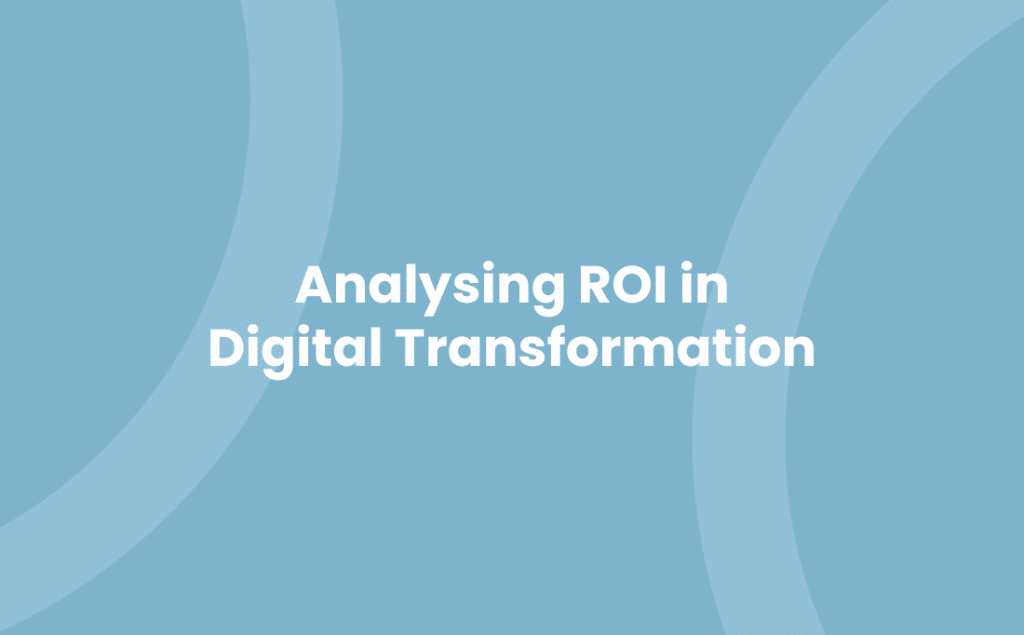Navigating the choppy waters of digital transformation can often feel like a daunting task. You’re constantly faced with key decisions, each with its own potential for high returns or costly mistakes. But what if you could take the guesswork out of these decisions? Welcome to the world of Digital Transformation ROI analysis.
This strategic tool is your secret weapon for maximising the return on your digital investments. It’s about understanding the financial impact of your digital initiatives, allowing you to make informed choices and secure the best possible outcomes. So, buckle up, as we delve into the intriguing world of Digital Transformation ROI analysis. You’re about to discover how it can revolutionise your approach to digital transformation, and why it’s a must-have in your strategic arsenal.
Understanding Digital Transformation
Grasping the concept of digital transformation represents the heart of profitable investment strategies. This knowledge acts as a pivot for maximising investments in global technological advancements. Let’s delve into the fundamentals of this concept.
Digital transformation, also known as ‘digitalisation’, encompasses significant changes to functions, processes, activities, and models of an organisation, facilitated by the innovative applications of digital technologies. The goal isn’t just the adoption of new digital tools, nor it’s about housing traditional operations with contemporary technology. It involves the rethinking of strategies, structures, processes, and operations in your business to adapt to a new digital age.
Delving deeper into the topic, this restructuring isn’t merely about shifting toward the digital; it focuses on using digital tools to augment the value of your business. It’s about capitalising on digital technologies to optimise productivity, improve quality, and expand your operations.
What does digital transformation signify to a business owner like yourself? The surge of digitalisation presents an excellent opportunity for you to reach wider markets, streamline your operations, ultimately achieving higher ROIs. More than a necessity, consider it an opportunity to scale your business.
However, the question of ‘ROI in digital transformation’ is a topic worth pondering upon. In simpler terms, ‘digital transformation ROI’ refers to a measurement of the returns on your digital investments. Just like any business activity you invest in, it’s essential to monitor and assess the performance of your digital investments.
This process of ‘digital ROI analysis’ involves calculating the benefits derived from your digital investments compared to the amount spent. The benefits could be intangible, such as increased customer satisfaction, or tangible, like increased sales. The aim is to guide your strategies by providing insights into what works and what doesn’t in your digital transformation journey.
In essence, understanding digital transformation stretches beyond the surface definition. It requires a comprehensive understanding of its implications on ROI. Furthermore, it calls for a proactive approach to adapt and revolutionise strategies in line with the ever-progressing digital landscape.
ROI Analysis in the Digital Transformation Journey
Embarking on a digital transformation requires a substantial investment, both in terms of resources and time. That’s where the digital transformation ROI, or Return On Investment, comes into the picture. It’s the measure that validates your digital initiatives, revealing their true value within a particular time frame.
One paramount aspect of digital transformation ROI analysis is its focus on cost savings versus the investment. For every digital strategy deployed, your business reduces some costs, like operational and managerial expenses. A proper ROI analysis identifies these savings, compares them with the initial and ongoing investment costs, and represents the returns as a percentage.
A second pivotal point for digital ROI analysis is operational efficiency. The digitisation process often introduces automated solutions, eliminating manual tasks and increasing employee productivity. Here again, ROI analysis calculates these efficiency gains against investment, delivering a solid ground for decision-making. A significantly improved efficiency implies a successful digital transformation.
Thirdly, ROI analysis should consider the new revenue streams facilitated by digital transformation. For instance, the implementation of e-commerce platforms allows businesses to expand to online marketplaces, increasing sales. The nuanced digital ROI analysis calculates the additional revenue generated, offering a realistic measure of digital investment profitability.
Bear in mind, gauging the true value of digital transformation isn’t exclusively tied to tangible financial gains. Indeed, improved customer experiences or employee satisfaction are vital yet intangible benefits of digitalisation. In this context, digital transformation ROI analysis extends beyond direct financial metrics, encompassing these indirect benefits as well.
In a nutshell, ROI analysis on the digital transformation journey provides an in-depth understanding of impacts, returns, and the overall success of your business’s digital shifts. It’s an instrumental tool to help guide strategic decisions, ensuring every digital initiative undertaken brings value to your business. It’s not just about spending on digitalisation; it’s about knowing where your money’s going and how much it’s bringing back. Remember, digital transformation is a journey, navigated step by step, with each decision backed by digital ROI analysis.
Steps to Conduct a Digital Transformation ROI Analysis
Embarking on the journey of Digital Transformation? It’s beneficial to have an understanding of your return on investment. Performing a digital ROI analysis can get tricky. However, fear not, follow this process and you’ll be reap the rewards in no time.
- Define Your Goals: Set tangible, measurable goals for your digital transformation. Clear goals might include, for instance, increased efficiency, reduced costs, or an enhanced customer experience. Understanding what you want to achieve keeps the transformation on track.
- Assign Monetary Value: This might be a bit tricky. Yet, it’s essential to attribute every defined goal with a monetary value. Consider assigning currency amounts to aspects like time saved, customer retention and improved productivity.
- Calculate the Investment: Just as the value, the complete investment should be assessed. Include costs such as technology, training, labour, and any other resources utilised in the transformation.
- Measure and Compare: This is where your digital transformation ROI comes into play. Calculate ROI using the formula: (net benefit / total cost)*100. This gives the ROI as a percentage. Quite straightforward when you get the hang of it.
- Monitor and Adjust: An ROI analysis is not a one-time event, but an ongoing process. You’ll need to track your progress continually, and make adjustments as necessary. Always remember, digital scapes evolve; staying flexible is key.
By following these steps systematically, you’ll obtain a comprehensive picture of your digital transformation ROI. You’ll also draw insights that are vital in making informed strategic decisions. So, go on. Get ready to unravel the mysteries surrounding your digital journey. After all, nothing speaks louder than numbers.
Real World Case Studies of Digital Transformation ROI Analysis
Embarking on a digital transformation journey equates to anticipation of a tangible return on investment (ROI). In the realm of business, numbers matter. That said, we’ll explore real-world examples that have successfully mastered the art of digital transformation ROI analysis.
Tesco Bank Transformation
In 2017, Tesco Bank, a key player in the UK’s finance sector, embarked on a pioneering project, centre-staging digital transformation. The focus centred on modernising IT systems, optimising customer experience, and driving operational efficiency. Resultantly, they reported a positive ROI within two years post implementation. A testament to the role of precise ROI analysis within digital transformation.
RBS Migration
Royal Bank of Scotland (RBS) serves as another powerful illustration. RBS decided to migrate their banking applications to a central cloud platform. They pursued this step to not only improve customer service but also to reduce costs. By implementing a diligent digital ROI analysis strategy, RBS witnessed massive cost savings, validating the effectiveness of their digital transformation.
Berendsen UK Migration
Berendsen UK, a leading provider of textile services, seamlessly migrated applications to Microsoft Azure to boost their business agility. By evaluating business needs against cloud benefits, they landed on an effective digital transformation ROI plan. This resulted in increased service speed, reduced downtime, and consolation of impressive savings.
These instances offer a glimpse into the critical essence of digital ROI analysis. Insightful, systematic, and strategic thinking form the bedrock of a foolproof digital transformation ROI plan. Following the footsteps of business catalysts like Tesco Bank, RBS, or Berendsen UK, your business too can reap the benefits of successful digital transformation. The key lies in harnessing the potential of digital ROI analysis correctly.
Remember, the compass guiding your digital revolution points towards measurable returns, if only navigated meticulously. Your strategic decisions, powered by a robust ROI analysis strategy, pave the way for meaningful digital evolution. The examples elucidated provide robust evidence for benefits of a well-executed digital transformation ROI analysis- a roadmap towards securing enhanced, quantifiable returns on your strategic digital investments.
Overcoming Challenges in Digital Transformation ROI Analysis
Sharpen your focus, as addressing hurdles in digital transformation ROI analysis is no pie in the sky. Mastering the art of surmounting these challenges can empower your business to scale new heights.
- Aligning Business and Digital Strategy: Perfect alignment between your digital strategy and overall business strategy ensures maximised ROI. However, achieving this alignment isn’t always a cakewalk. Develop a holistic approach in your decision-making process and involve key stakeholders. This integrated method aids in mitigating potential conflicts and fosters synergy across your organisation’s strategies.
- Data Quality: Dealing with disparate and unstructured data can be like finding a needle in a haystack. Poor data quality may result in skewed digital ROI analysis. You can tackle this issue by implementing stringent data governance policies. Opt for comprehensive data management tools that enable effective data filtering, cleaning, and validation.
- Justifying ROI of Futuristic Technologies: Demonstrating the ROI of emerging tech, like AI or IoT, can feel like trying to nail jelly to a wall. The returns aren’t immediately tangible but they’re there, hiding in the long term. Adopt a future-oriented mindset and calculate the potential value these technologies might bring over time.
- Lack of Skilled Professionals: Think of your team as the gears of a well-oiled machine; If the gears aren’t fit, the machine stalls. A team ill-equipped in digital proficiency can impede effective ROI analysis. Bolster your team’s digital skills through training and upskilling sessions, and by hiring proficient talent.
- Failure to Adapt to Rapid BAU Activities: Fluidity is the key to survival in rapidly evolving digital landscapes. If your business finds it difficult to adjust to rapid business-as-usual (BAU) activities, it might lead to ineffective digital ROI analysis. Implement agile methodologies to strengthen your business adaptability and resilience.
- Security Concerns: A single breach can send years of hard work down the drain. Cybersecurity issues pose a significant challenge to digital transformation and, by extension, its ROI analysis. Invest in robust cybersecurity measures and boost your digital resilience to safeguard your ROI.
By cracking these challenges, you set the stage for successful digital transformation ROI analysis‚ the key to propelling your business to the crest of the digital wave. After all, challenges are what make life exciting and overcoming them is what makes life meaningful.
Optimising ROI for Future Digital Transformation Initiatives
In your relentless journey of digital progression, optimising ROI becomes a significant concern. Let’s explore strategic ways to harness maximum returns from future Digital Transformation initiatives.
Planning the Digital Transformation Roadmap
A well-planned roadmap is the starting point. Identify the transformative digital channels and technologies considering their potential impact on your business. For a practical roadmap, consider factoring in your current digital state, desired digital maturity, and achievable targets given your budget and resources.
Prioritising Value-generating Areas
By prioritising high potential areas, profitability follows suit. Dell Technologies, for instance, optimised their digital ROI analysis by focusing on automating manual processes. That translated into cost savings and efficiency improvements that dramatically bolstered their ROI.
Investing in Employee Training and Upskilling
The prowess of your workforce cannot be underestimated when getting the most out of digital transformation. Studies indicate that companies investing in employee training and upskilling attest to better digital ROI.
Implementing Robust Cybersecurity Measures
It’s imperative for your digital security to be unbreachable. Poor data security can lead to costly breaches, thus undermining your digital ROI analysis. Companies with advanced cybersecurity strategies mitigate this risk.
Continuous Refining and Improvement
Adopting a flexible approach enables continuous refinement in the light of feedback, dynamic business needs and evolving technology. Adaptability remains key to optimising the digital transformation ROI, propelling your business into the digital future with confidence.
Evaluating ROI using the Right Metrics
Finally, metrics matter. Determining the success of digital transformation initiatives should go beyond the financials. Evaluating factors such as process efficiency, customer satisfaction rates, and employee productivity can give a comprehensive insight into your digital transformation ROI.
Firming up your ROI from digital transformation isn’t merely a numbers game, but a substantial move to drive growth and sustain value in the digital age. By anchoring your digital transformation initiatives on the steps above, you may reap substantial returns and secure your business’s future in the digital landscape.
Conclusion
So, you’ve seen how digital transformation ROI analysis plays a crucial role in maximising your tech investments. You’ve learnt from the success stories of Tesco Bank, RBS, and Berendsen UK. You’ve understood the challenges that come with it and how to tackle them head-on. You’re now equipped with strategies to optimise your ROI in future initiatives. It’s all about aligning your business and digital strategies, addressing data quality, investing in your workforce, and keeping up with rapid business changes. Remember, cybersecurity is not an option, it’s a necessity. With continuous refinement and the right metrics, you’ll be able to evaluate your ROI effectively. By doing so, you’re not just improving your ROI, but also driving growth and securing your position in the digital landscape. That’s the power of digital transformation ROI analysis.


